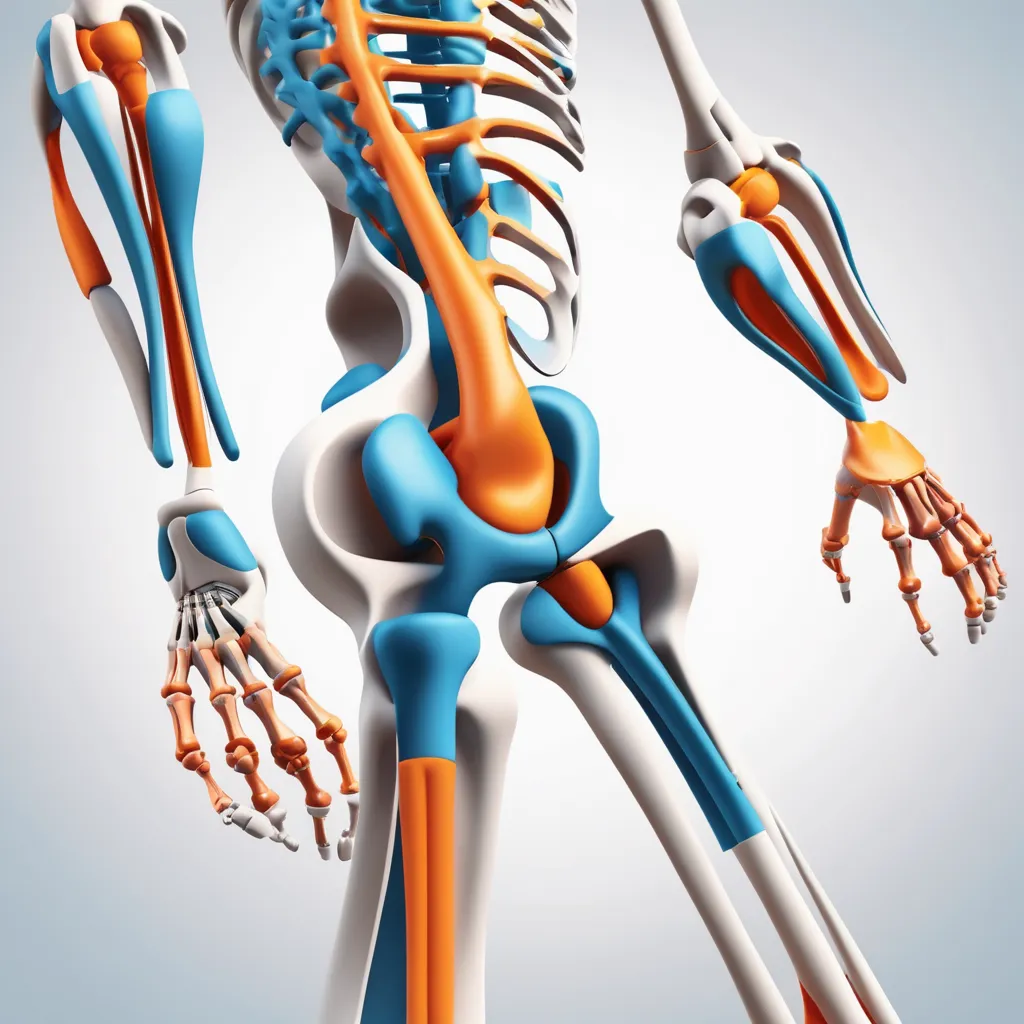Our bodies are incredible machines, capable of a wide range of movements and activities. At the heart of this flexibility and mobility are our joints – the connections between bones that allow for movement. Understanding the different types of joints in our body can help us appreciate their function and importance, especially when it comes to maintaining our overall health and addressing issues like joint pain or injury.
In this comprehensive guide, we’ll explore the four main types of joints in the human body, their functions, and how to care for them. We’ll also discuss when it might be necessary to seek help from a joint pain doctor specialist or visit a pain and joint clinic.
The 4 Types of Joints
1. Synovial Joints
Synovial joints are the most common and most movable type of joint in the human body. They’re characterized by a synovial cavity filled with synovial fluid, which lubricates the joint and reduces friction during movement.
Key features of synovial joints:
- Enclosed by a joint capsule
- Lined with synovial membrane
- Contain articular cartilage on the opposing bone surfaces
- Allow for a wide range of motion
Examples of synovial joints include:
- Knee joint
- Hip joint
- Shoulder joint
- Elbow joint
These joints are often the focus of treatment at a bone and joint hospital near me due to their susceptibility to wear and tear, injuries, and conditions like osteoarthritis.
2. Cartilaginous Joints
Cartilaginous joints are characterized by bones connected by cartilage. There are two types of cartilaginous joints:
- a) Synchondrosis: These joints are formed by hyaline cartilage and are typically temporary, found in growing bones. An example is the growth plate in children’s bones.
- b) Symphysis: These joints are formed by fibrocartilage and allow for slight movement. Examples include the pubic symphysis and the intervertebral discs between vertebrae.
Cartilaginous joints play crucial roles in growth and providing stability. Issues with these joints may require attention from specialists at a joint and bone care hospital.
3. Fibrous Joints
Fibrous joints are characterized by bones connected by dense fibrous tissue. They allow for little to no movement and provide stability.
Types of fibrous joints include:
- a) Sutures: Found between the bones of the skull b) Gomphosis: The connection between teeth and their sockets c) Syndesmosis: Joints held together by ligaments, such as the joint between the tibia and fibula
While less prone to injury than synovial joints, fibrous joints can still be affected by conditions that may require treatment from a bone and joint doctor.
4. Bony Joints (Synostosis)
Bony joints, also known as synostosis, occur when separate bones fuse together to form a single bone. This process can happen naturally during development or as a result of injury or disease.
Examples of bony joints include:
- The fusion of the sacral vertebrae to form the sacrum
- The fusion of the pelvic bones in adults
While bony joints themselves don’t typically cause issues, the process of bone fusion or complications from it may sometimes require intervention from a best joint replacement surgeon.
The Importance of Joint Health
Maintaining healthy joints is crucial for overall mobility and quality of life. Here are some key ways to promote joint health:
- Regular Exercise Engaging in low-impact exercises like swimming, cycling, or yoga can help keep joints flexible and strengthen the muscles supporting them.
- Maintaining a Healthy Weight Excess weight puts additional stress on weight-bearing joints like knees and hips. Maintaining a healthy weight can significantly reduce the risk of joint problems.
- Proper Nutrition A balanced diet rich in anti-inflammatory foods, omega-3 fatty acids, and vitamins C and D can support joint health.
- Good Posture Maintaining proper posture, especially when sitting for long periods, can help prevent unnecessary strain on your joints.
- Adequate Rest and Recovery Giving your body time to rest and recover, especially after intense physical activity, is crucial for joint health.
When to Seek Professional Help
While minor joint discomfort can often be managed at home, certain symptoms warrant a visit to a joint pain clinic or consultation with a specialist. These include:
- Persistent joint pain lasting more than a few days
- Swelling, redness, or warmth around a joint
- Decreased range of motion
- Joint instability or weakness
- Unexplained weight loss or fever accompanying joint pain
In such cases, it’s advisable to seek help from a bone and joint specialist who can provide an accurate diagnosis and appropriate treatment plan.
Common Joint Conditions and Treatments
- Osteoarthritis This degenerative joint disease is characterized by the breakdown of cartilage in joints. Treatment may include pain management, physical therapy, and in severe cases, joint replacement surgery performed by a best joint replacement surgeon.
- Rheumatoid Arthritis An autoimmune disorder causing inflammation in joints. Treatment typically involves medications to control inflammation and slow disease progression.
- Gout A form of arthritis caused by the buildup of uric acid crystals in joints. Treatment includes medications to reduce pain and inflammation, as well as dietary changes.
- Bursitis Inflammation of the fluid-filled sacs (bursae) that cushion joints. Treatment may include rest, physical therapy, and sometimes corticosteroid injections.
- Tendinitis Inflammation of tendons connecting muscles to bones. Treatment often involves rest, physical therapy, and anti-inflammatory medications.
The Role of Specialized Care
For complex joint issues or when conservative treatments aren’t effective, specialized care may be necessary. This is where facilities like a joint hospital or bone & joint hospital come into play. These specialized centers offer comprehensive care for a wide range of joint and bone conditions.
A joint care hospital typically provides services such as:
- Advanced diagnostic imaging
- Minimally invasive arthroscopic procedures
- Joint replacement surgeries
- Rehabilitation services
- Pain management techniques
When choosing a bone and joint care hospital, consider factors such as:
- The expertise and experience of the medical staff
- Available treatment options and technologies
- Patient reviews and success rates
- Location and accessibility
The Future of Joint Care
Advancements in medical technology are continually improving the field of joint care. Some exciting developments include:
- Regenerative Medicine Techniques like stem cell therapy and platelet-rich plasma (PRP) injections show promise in promoting natural healing of damaged joints.
- Robotic-Assisted Surgery Robotic systems are enhancing the precision of joint replacement surgeries, potentially leading to better outcomes and faster recovery times.
- 3D Printing Custom 3D-printed joint implants are becoming a reality, offering the potential for more personalized and effective joint replacements.
- Wearable Technology Smart devices are being developed to monitor joint health, track movement patterns, and provide early warning signs of potential joint issues.
Frequently Asked Questions
- Q: What types of joint conditions does Dr. Archana Rathi specialize in treating?
A: Dr. Archana Rathi specializes in treating a wide range of joint conditions, including osteoarthritis, rheumatoid arthritis, sports injuries, and degenerative joint diseases. - Q: Does Dr. Archana Rathi offer minimally invasive joint treatments?
A: Yes, Dr. Rathi is skilled in various minimally invasive procedures, including arthroscopic surgeries, which can lead to faster recovery times and less postoperative pain. - Q: How does Dr. Archana Rathi approach joint pain management?
A: Dr. Rathi takes a comprehensive approach to joint pain management, combining advanced medical treatments with lifestyle modifications, physical therapy, and when necessary, surgical interventions. - Q: Can Dr. Archana Rathi help with joint replacement surgeries?
A: Absolutely. Dr. Rathi is an experienced joint replacement surgeon, offering both traditional and innovative techniques for hip, knee, and shoulder replacements. - Q: What should I expect during my first consultation with Dr. Archana Rathi for joint issues?
A: During your initial consultation, Dr. Rathi will conduct a thorough evaluation, which may include a physical examination, review of your medical history, and potentially ordering diagnostic tests to develop a personalized treatment plan.
Conclusion: Take the First Step Towards Better Joint Health with Dr. Archana Rathi
Understanding the four types of joints in our body is just the beginning of maintaining optimal joint health. Whether you’re dealing with persistent joint pain, considering joint replacement, or simply want to take proactive steps to protect your joints, expert care is crucial.
Dr. Archana Rathi, with her extensive experience and comprehensive approach to joint care, is here to guide you on your journey to better joint health. Don’t let joint issues hold you back from living your best life. Take action today by scheduling a consultation with Dr. Rathi.
Contact our office to book your appointment and take the first step towards healthier, pain-free joints. Let Dr. Archana Rathi help you move better, feel better, and live better. Your joints will thank you!



